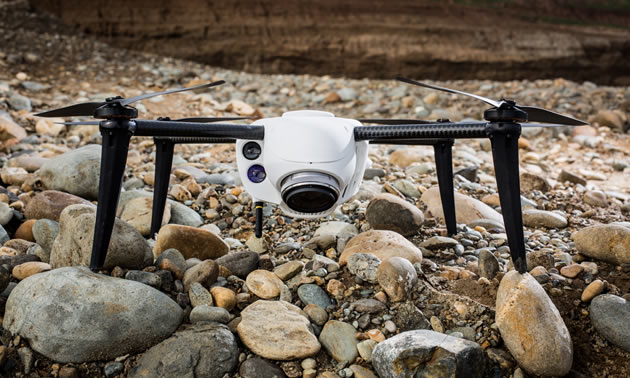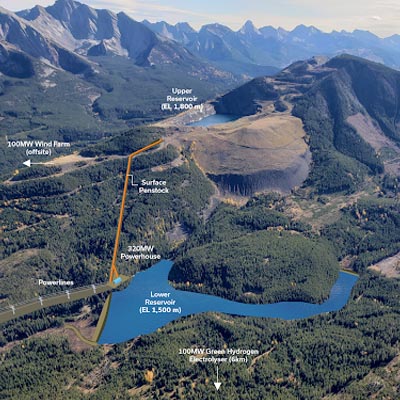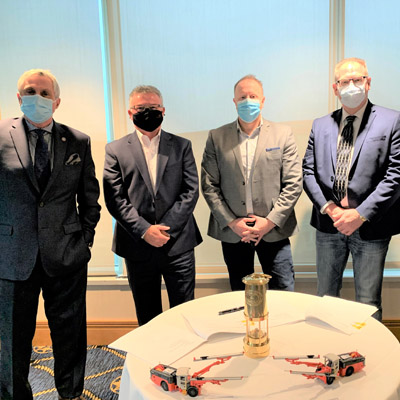Innovations in mining are taking off with Kespry’s drones
These autonomous drones are easy to use while increasing efficiency and profits in mining

Kespry drones are subscription-based, so their customers can grow with the drones as new technology is created. — Photo courtesy Kespry
Drone innovation for Kespry is centred around ease of use. Kespry’s drones fly autonomously—no piloting needed after the flight path is mapped on an iPad. In terms of data collection, the Kespry Cloud automatically transfers and processes data to present it in a digestible way for customers.
When working with Kespry, the customer receives a commercial-grade drone, registration, training and ongoing support. Accidents are remedied, and the iPad control updates automatically. The subscription-based model allows for seamless hardware and software updates without the depreciation, learning curve and registration paperwork of ownership.
“The beauty about our subscription model is that you are growing with the technology,” said Jason Nichols, product marketing manager at Kespry, which has its headquarters in Menlo Park, California.
The use of drones in mining is becoming increasingly popular, especially with coal, frac sand, gold and iron ore. “They are used to collect survey data for analysis, to update mine plans or to give an assessment of the site surface,” said Nichols. “Mines have traditionally done that through different manual methods or survey equipment.”
Kespry’s drones are innovative in their accessibility. “We offer a system that doesn’t require high-tech skills,” Nichols said. They offer high-resolution, accurate data, quicker than traditional methods, but the automatic data delivery and ease of use sets them apart. Integrating a Kespry drone is a seamless transition into the operation’s workflow.
Efficiency through drone data collection
“Drone technology allows us to improve the frequency, accuracy and ease of use to acquire data,” Nichols said. With the help of drones, stockpile measurement, inventory management and mine planning are now automated and efficient as well as more frequently tracked with the addition of accurate data. Saved time, lowered costs, increased safety and increased revenue are the typical results a mine experiences when implementing drones into their operations.
Peabody Energy, for example, has used Kespry drones for its multi-site tracking needs at its coal operations. “They have a lot of material to account for on a daily basis,” said Nichols. “They weren’t able to keep up with that using traditional equipment, so they moved to drone technology with Kespry.”
Peabody used drones over the range of its operations: from mine planning and permitting to reserve modelling and tracking, all the way to managing reclamation. Through drone use, they were able to increase their awareness of their production levels and increase their efficiency of extraction. By the end of the year, they had a more accurate assessment of what was extracted and ideas on how they could better refine their operations. “The time saving they’ve achieved is significant,” said Nichols.
The future of drones in mining
While the industry is always evolving, customer feedback helps Kespry offer innovative solutions that grow. “We are constantly developing features within our Kepsry Cloud and updating our hardware,” Nichols said, thereby answering the direct needs of their customers.
One way Nichols thinks drones will improve mining is through the development of sensors that can be applied to existing systems that collect different types of data. “For example, if you have a thermal sensor, you are able to not just look at the stockpile inventories but the heat signature within that pile,” he said. “For a coal mine plant, you could get a lot more data in a single flight.”
As they can collect more data, Kespry wants to add more ways to analyze the data to their Kespry Cloud. “The more data you have for a single solution, the more robust data you can pull out,” he said. “The development of the cloud, artificial intelligence and deep learning capabilities allows companies to leverage different types of data.”
The future of drones ultimately lies in the development of technologies that fit seamlessly into existing workflows. They should continue to offer an efficient solution to traditionally challenging, time-consuming or inefficient tasks.




